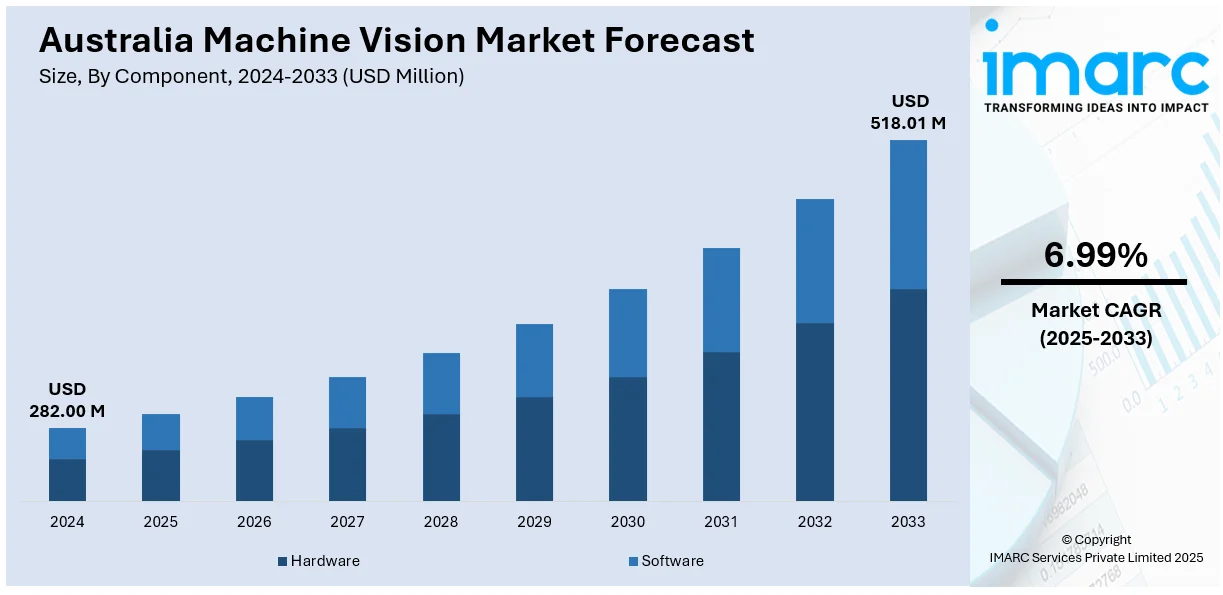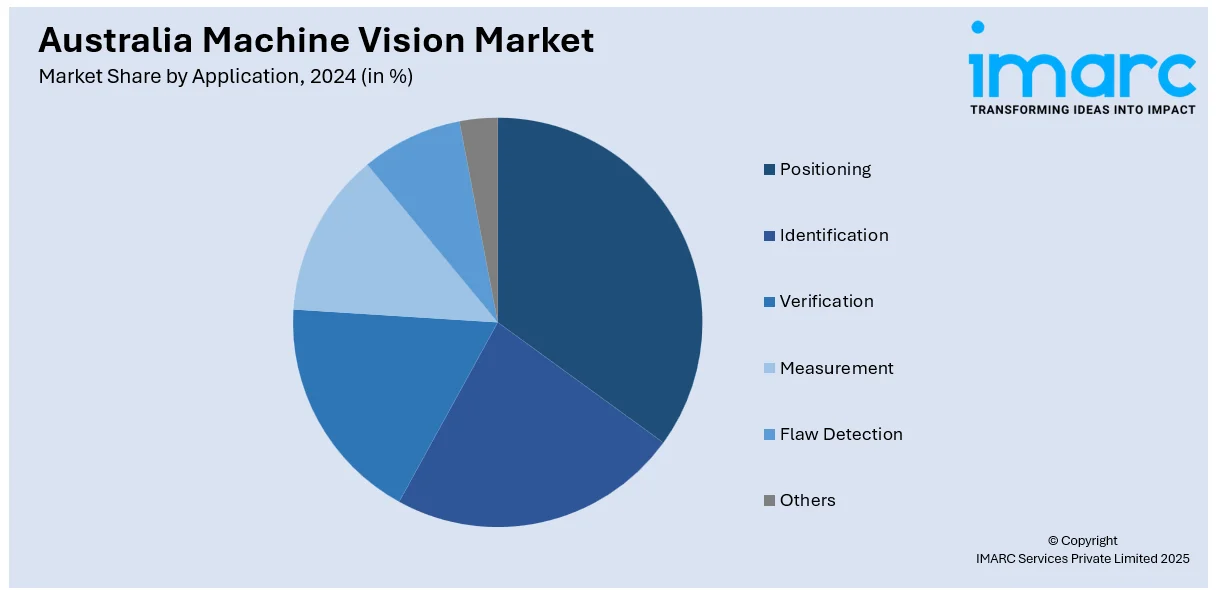
Australia Machine Vision Market Size, Share, Trends and Forecast by Component, Product, Application, End Use Industry, and Region, 2025-2033
Australia Machine Vision Market Overview:
The Australia machine vision market size reached USD 282.00 Million in 2024. Looking forward, IMARC Group expects the market to reach USD 518.01 Million by 2033, exhibiting a growth rate (CAGR) of 6.99% during 2025-2033. Technological advancements, rising automation needs across sectors, increasing adoption of smart manufacturing, integration of artificial intelligence (AI) and deep learning, and the shift toward Industry 4.0 are pushing the market growth. Surging product demand in logistics, warehousing, and pharmaceutical sectors, the use of three-dimensional (3D) vision, focus on quality control, and rapid improvements in camera and sensor technology are supporting the market growth. Apart from this, labor shortages, supportive government initiatives, growing use of robotics, and locally tailored solutions are further boosting the Australia machine vision market share.
|
Report Attribute
|
Key Statistics
|
|---|---|
|
Base Year
|
2024 |
|
Forecast Years
|
2025-2033
|
|
Historical Years
|
2019-2024
|
| Market Size in 2024 | USD 282.00 Million |
| Market Forecast in 2033 | USD 518.01 Million |
| Market Growth Rate 2025-2033 | 6.99% |
Australia Machine Vision Market Trends:
Rising Automation in Manufacturing Sectors
The rise in automation within Australia's manufacturing industry is one of the key factors driving the demand for machine vision. The mining and food processing industries are using these systems to improve efficiency, reduce human errors, and better control quality. Machine vision helps detect defects on packaging during food manufacturing, identify foreign objects, and label correctly. Mining operations are applying vision systems to monitor equipment and conveyor belts for early fault detection and reduced operations. The demand is further being propelled by the need to maintain high levels of productivity, especially with rising labor costs and safety concerns in arduous work conditions. With manufacturers seeking more reliable and stable production lines, machine vision is taking center stage as an investment priority.

To get more information on this market, Request Sample
Integration of AI and Deep Learning
Artificial intelligence (AI) and deep learning are transforming machine vision systems, making them smarter and more responsive. With AI, they can learn from images, recognize subtle differences, and improve accuracy over time. This is especially particular in industries like electronics, auto components, and consumer electronics, where minor differences can make a difference to the quality of the product. In Australia, firms are finding focusing in machine vision based on AI as it reduces false detection and improves inspection results. These machines can also operate at higher speeds with less human intervention, which is further driving the market to grow. This shift is allowing companies to enhance their quality control processes and deal with increased production demands and stricter quality specifications, which is further propelling the market growth.
Push Towards Industry 4.0 Adoption
Australia's growing shift towards Industry 4.0 is also playing a strong role in the accelerating application of machine vision. Industry 4.0 entails the connection of machines, systems, and processes for smarter and more effective operations. Machine vision provides real-time feedback from production lines, which helps companies monitor performance, identify problems early, and automate other tasks. For instance, it can check if parts are correctly placed on an assembly line or detect errors in product packaging. Businesses are starting to see how machine vision fits into their digital strategies, especially when combined with IoT platforms and factory automation software. Furthermore, government programs promoting advanced manufacturing are also encouraging this transition, which is driving the Australia machine vision market growth.
Australia Machine Vision Market Segmentation:
IMARC Group provides an analysis of the key trends in each segment of the market, along with forecasts at the country and regional levels for 2025-2033. Our report has categorized the market based on component, product, application, and end use industry.
Component Insights:
- Hardware
- Software
The report has provided a detailed breakup and analysis of the market based on the component. This includes hardware and software.
Product Insights:
- Vision Systems
- Cameras
- Others
A detailed breakup and analysis of the market based on the product have also been provided in the report. This includes vision systems, cameras, and others.
Application Insights:

- Positioning
- Identification
- Verification
- Measurement
- Flaw Detection
- Others
The report has provided a detailed breakup and analysis of the market based on the application. This includes positioning, identification, verification, measurement, flaw detection, and others.
End Use Industry Insights:
- Electronics and Semiconductor
- Automotive
- Medical and Pharmaceutical
- Food, Packaging and Printing
- Security and Surveillance
- Intelligent Traffic System
- Others
A detailed breakup and analysis of the market based on the end use industry have also been provided in the report. This includes electronics and semiconductor, automotive, medical and pharmaceutical, food, packaging and printing, security and surveillance, intelligent traffic system, and others.
Regional Insights:
- Australia Capital Territory & New South Wales
- Victoria & Tasmania
- Queensland
- Northern Territory & Southern Australia
- Western Australia
The report has also provided a comprehensive analysis of all the major regional markets, which include Australia Capital Territory & New South Wales, Victoria & Tasmania, Queensland, Northern Territory & Southern Australia, and Western Australia.
Competitive Landscape:
The market research report has also provided a comprehensive analysis of the competitive landscape. Competitive analysis such as market structure, key player positioning, top winning strategies, competitive dashboard, and company evaluation quadrant has been covered in the report. Also, detailed profiles of all major companies have been provided.
Australia Machine Vision Market News:
- In 2024, Shield AI acquired Australia's Sentient Vision Systems, integrating its ViDAR optical detection technology with Shield's Hivemind AI pilot. This merger enhances real-time situational awareness capabilities for defense applications and establishes Shield AI's presence in the Australian market.
- In 2024, Melbourne-based Esper Satellite Imagery secured a USD 1 million prize at the Croc Pitch innovation awards. Their hyperspectral sensors, capable of capturing detailed chemical compositions, offer cost-effective imaging solutions for mining, agriculture, and environmental monitoring.
Australia Machine Vision Market Report Coverage:
| Report Features | Details |
|---|---|
| Base Year of the Analysis | 2024 |
| Historical Period | 2019-2024 |
| Forecast Period | 2025-2033 |
| Units | Million USD |
| Scope of the Report |
Exploration of Historical Trends and Market Outlook, Industry Catalysts and Challenges, Segment-Wise Historical and Future Market Assessment:
|
| Components Covered | Hardware, Software |
| Products Covered | Vision Systems, Cameras, Others |
| Applications Covered | Positioning, Identification, Verification, Measurement, Flaw Detection, Others |
| End Use Industries Covered | Electronics and Semiconductor, Automotive, Medical and Pharmaceutical, Food, Packaging and Printing, Security and Surveillance, Intelligent Traffic System, Others |
| Regions Covered | Australia Capital Territory & New South Wales, Victoria & Tasmania, Queensland, Northern Territory & Southern Australia, Western Australia |
| Customization Scope | 10% Free Customization |
| Post-Sale Analyst Support | 10-12 Weeks |
| Delivery Format | PDF and Excel through Email (We can also provide the editable version of the report in PPT/Word format on special request) |
Key Questions Answered in This Report:
- How has the Australia machine vision market performed so far and how will it perform in the coming years?
- What is the breakup of the Australia machine vision market on the basis of component?
- What is the breakup of the Australia machine vision market on the basis of product?
- What is the breakup of the Australia machine vision market on the basis of application?
- What is the breakup of the Australia machine vision market on the basis of end use industry?
- What is the breakup of the Australia machine vision market on the basis of region?
- What are the various stages in the value chain of the Australia machine vision market?
- What are the key driving factors and challenges in the Australia machine vision market?
- What is the structure of the Australia machine vision market and who are the key players?
- What is the degree of competition in the Australia machine vision market?
Key Benefits for Stakeholders:
- IMARC’s industry report offers a comprehensive quantitative analysis of various market segments, historical and current market trends, market forecasts, and dynamics of the Australia machine vision market from 2019-2033.
- The research report provides the latest information on the market drivers, challenges, and opportunities in the Australia machine vision market.
- Porter's five forces analysis assist stakeholders in assessing the impact of new entrants, competitive rivalry, supplier power, buyer power, and the threat of substitution. It helps stakeholders to analyze the level of competition within the Australia machine vision industry and its attractiveness.
- Competitive landscape allows stakeholders to understand their competitive environment and provides an insight into the current positions of key players in the market.
Need more help?
- Speak to our experienced analysts for insights on the current market scenarios.
- Include additional segments and countries to customize the report as per your requirement.
- Gain an unparalleled competitive advantage in your domain by understanding how to utilize the report and positively impacting your operations and revenue.
- For further assistance, please connect with our analysts.
 Request Customization
Request Customization
 Speak to an Analyst
Speak to an Analyst
 Request Brochure
Request Brochure
 Inquire Before Buying
Inquire Before Buying




.webp)




.webp)












